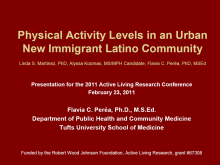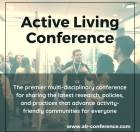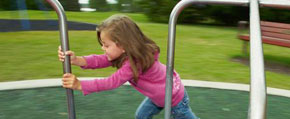We are pleased to announce an exciting new alliance between Active Living Research and GP RED to co-host and coordinate...
Physical Activity Levels in an Urban New Immigrant Latino Community

Presentation at the 2011 Active Living Research Annual Conference
Background:
The health benefits of physical activity are well documented. Moderate amounts of physical activity can reduce the risk of chronic conditions such as cardiovascular disease, diabetes and obesity. Despite the well known benefits of physical activity, Americans overall have low levels of physical activity. In 2010 Tufts University researchers in collaboration with the City of Lawrence Massachusetts, Mayor’s Health Task Force set out to develop policy approaches to increase physical activity among city residents.
Lawrence is a minority-majority city north of Boston. Latinos, mainly from the Caribbean islands of Puerto Rico and the Dominican Republic, represent 69.4% of the population. The city has 72,000 residents of which 33,586 are foreign born. Lawrence is home to a young population, where 30% is under 18 years, almost half is under age 24 (43%), and the median age is 32. The child demographic is overwhelmingly minority, as according to the Massachusetts Department of Education the student population is 89.1% Latino. In Lawrence, only 40.1% of adults reported participating in regular physical activity.
Objectives:
As part of a larger study of the relationship between the maintenance and management of parks and green spaces and park utilization, this paper illustrates the level and types of physical activity that urban Latino park goers in Lawrence, MA engage in, and looks at variations in physical activity-level by age and gender.
Methods:
Using the System for Observing Physical Activity & Recreation in Communities (SOPARC) physical activity data was collected for 24 parks in Lawrence, MA. The SOPARC is based on momentary time sampling techniques where systematic and periodic scans of individuals and contextual factors are made in parks and playgrounds. It allows for comparison of physical activity levels in the same or different settings over different periods of time. SOPARC assesses the number of people engaged in physical activity, the type of physical activity individuals are engaging in, and their physical activity levels.
In April of 2010 a group of local youth were hired and trained to implement the SOPARC. Each of the 24 parks was assessed six times weekly, with observations occurring three times a day, once during the week and once on a weekend. SOPARC data was entered in to Excel and then exported to STATA for analyses. Analyses included tabulations of raw counts for the number of people engaging in physical activity, as well as the type and level of physical activity people were engaged in. Finally, bivariate analyses were conducted. SOPARC data were examined by time of observation, age and sex to determine the presence differences in activity level based on these categories.
Results:
During the months of May and July of 2010 a total of 3,869 individuals were observed in the parks. Of those observed the majority (67%) were male. The age estimates for park goers can be seen in Table 1.
Table 1: Estimated Age of Park Goers
Child (<12 years): 34.8%
Teen (13-20 years): 28.1%
Adult (21-59 years): 35.7%
Senior (>60 years): 1.4%
The plurality of individuals in the parks were observed engaging in vigorous activity (45.4%), followed by those engaging in sedentary and moderate activity, 32.3% and 22.3% respectively. Data indicate that both age and gender are statistically significant predictors of activity level.
Conclusions:
Males were more likely than females to be engaging in vigorous physical activity. This finding is consistent with the literature, and in Lawrence may be due to the types of organized sports held in the parks. There are numerous baseball leagues which engage predominantly males, similarly males were more likely to be observed on basketball teams than females. Such organized sports may also account for differences seen by age, whereas adults in parks were more likely to be spectators.
Support:
Robert Wood Johnson Foundation, Active Living Research new connections program
Related Tools & Resources
STAY UP TO DATE
RECENTLY ADDED TOOLS & RESOURCES
MOVE! A BLOG ABOUT ACTIVE LIVING
The "Active Living Conference" aims to break down research and practice silos and...







